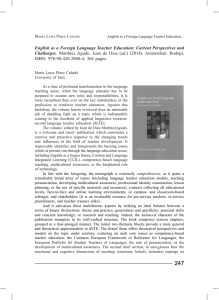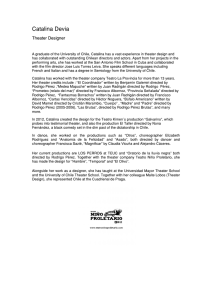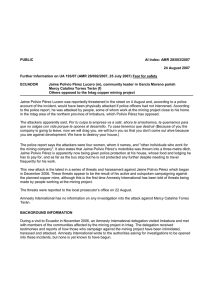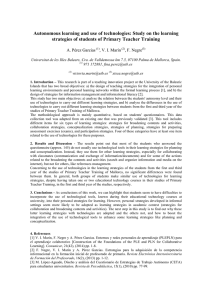Manuel Pérez Otero, Esbozo de la filosofía de Kripke, Montesinos
Anuncio
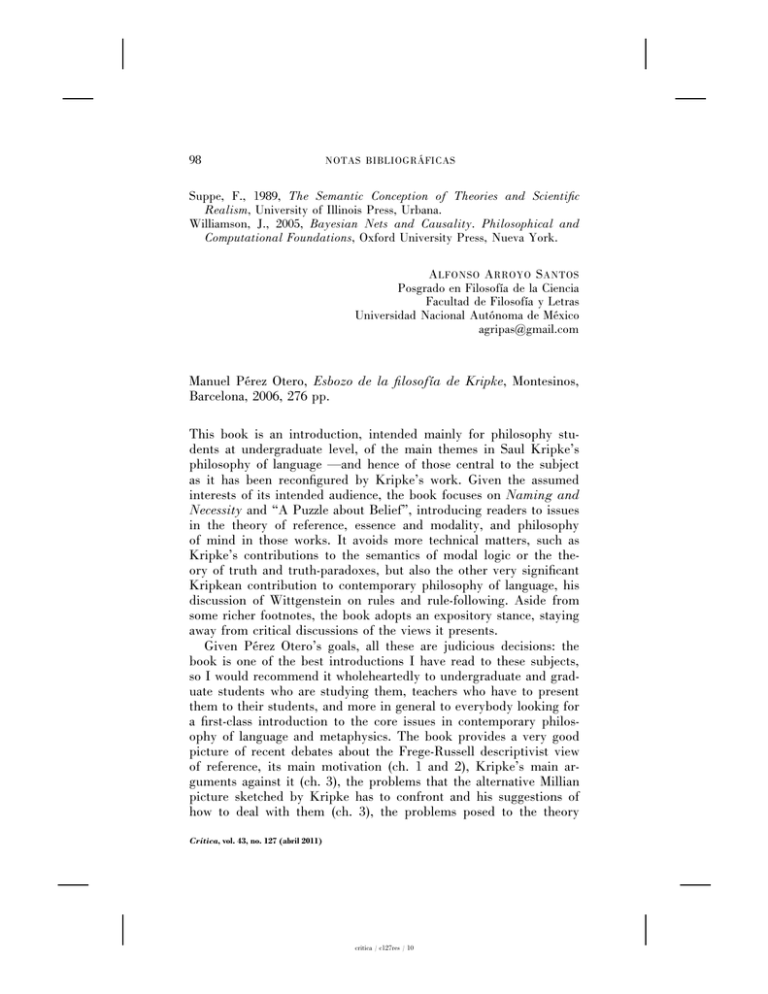
98 NOTAS BIBLIOGRÁFICAS Suppe, F., 1989, The Semantic Conception of Theories and Scientific Realism, University of Illinois Press, Urbana. Williamson, J., 2005, Bayesian Nets and Causality. Philosophical and Computational Foundations, Oxford University Press, Nueva York. A LFONSO A RROYO S ANTOS Posgrado en Filosofía de la Ciencia Facultad de Filosofía y Letras Universidad Nacional Autónoma de México [email protected] Manuel Pérez Otero, Esbozo de la filosofía de Kripke, Montesinos, Barcelona, 2006, 276 pp. This book is an introduction, intended mainly for philosophy students at undergraduate level, of the main themes in Saul Kripke’s philosophy of language —and hence of those central to the subject as it has been reconfigured by Kripke’s work. Given the assumed interests of its intended audience, the book focuses on Naming and Necessity and “A Puzzle about Belief”, introducing readers to issues in the theory of reference, essence and modality, and philosophy of mind in those works. It avoids more technical matters, such as Kripke’s contributions to the semantics of modal logic or the theory of truth and truth-paradoxes, but also the other very significant Kripkean contribution to contemporary philosophy of language, his discussion of Wittgenstein on rules and rule-following. Aside from some richer footnotes, the book adopts an expository stance, staying away from critical discussions of the views it presents. Given Pérez Otero’s goals, all these are judicious decisions: the book is one of the best introductions I have read to these subjects, so I would recommend it wholeheartedly to undergraduate and graduate students who are studying them, teachers who have to present them to their students, and more in general to everybody looking for a first-class introduction to the core issues in contemporary philosophy of language and metaphysics. The book provides a very good picture of recent debates about the Frege-Russell descriptivist view of reference, its main motivation (ch. 1 and 2), Kripke’s main arguments against it (ch. 3), the problems that the alternative Millian picture sketched by Kripke has to confront and his suggestions of how to deal with them (ch. 3), the problems posed to the theory Crítica, vol. 43, no. 127 (abril 2011) critica / c127res / 10 NOTAS BIBLIOGRÁFICAS 99 of reference by our practices of belief-ascription and their possible source (ch. 5), the role that modal matters play in contemporary accounts of meaning and truth-conditions (ch. 1 and 3), Kripke’s influential separation between modal and epistemic modality, necessary truth and a priori knowledge (ch. 3), his reinstatement of Aristotelian essentialism from its relegation since Hume and Kant to Carnap and Quine (ch. 6), and, last but not least, Kripke’s challenges to easily self-contented contemporary forms of materialism about the mindbody problem (ch. 4). Two very good examples of the virtues I am extolling in the book are provided by Pérez Otero’s discussion of two topics that are initially (and perhaps not just initially) puzzling to anybody approaching Kripke’s work. Firstly, the reason why it is not simply that unicorns and Sherlock Holmes do not exist, but (to put it crudely) in fact they could not have existed —Kripke himself had simply taken for granted in previous work that, even though Sherlock Holmes was a figment of Conan Doyle’s imagination, he of course could have existed (pp. 191–196). Secondly, the contention that, in contrast to the case of “water is H2 O” and “Hesperus is Phosphorus”, where there is an acceptable explanation for the illusory appearance that those statements are not necessary, in the case of “pain is C fiber stimulation” the best explanation is that the appearance is correct and thus the impression of contingency non-illusory (pp. 205–220). In both cases, the discussion is fully non-technical: nothing is said about the peculiarities of fictional discourse in the first case (which Kripke himself later addressed in an as yet unpublished set of lectures), or about fancy “two-dimensional semantics” in the second; I am pretty sure that any attentive reader of Pérez Otero’s introduction will have no difficulty in grasping Kripke’s train of thought. The text studiously avoids discussion of the huge controversy generated by these issues, especially the second one (to which I will come back later); but that was the intent. In spite of its introductory nature, the book includes original and illuminating material, starting with its main interpretative orientation, the linguistic particularism that Pérez Otero ascribes to Kripke. This is characterized (p. 27) as the thesis that the referential function of singling out particular entities played by singular terms (proper names paradigmatically) is not reducible to other functions performed by further expressions, in particular that of predicating or describing played by predicates. Pérez Otero (pp. 28, 258) contends that this is the most original aspect of Kripke’s thinking, given that other core features, such as its externalism, were shared Crítica, vol. 43, no. 127 (abril 2011) critica / c127res / 11 100 NOTAS BIBLIOGRÁFICAS by other influential writers in the New Theory of Reference wave, Hilary Putnam and Tyler Burge in particular. When it comes to the modal application of the view (“modal particularism”), it is difficult not to sympathize with Pérez Otero’s interpretative proposal —to the extent at least that one grasps what that “particularism” comes to, about which I will raise some doubts in the rest of this review. On the general philosophical issue of the irreducibility of referring, we should —I think— give due credit to Peter Strawson’s influential work in the fifties and sixties, and through him to Keith Donnellan’s; after all, the first anti-descriptivist publication in the New Theory of Reference tradition was not about names or demonstratives, but Donnellan’s (1966) Strawsonian piece on the referential use of descriptions. I will now expand on some doubts raised by Pérez Otero’s account of Kripkean particularism. On p. 111n., Pérez Otero explains why “Julius” is still a rigid singular term, in spite of its reference having been fixed by the non-rigid description “the inventor of the zip”: the reason is that “Julius” has not been stipulated to be just an abbreviation of the description, which would make it a description itself, but is assumed to be a proper name. Now, it is for us to stipulate how the reference of a name is fixed; it is also legitimate to stipulate whether an expression is to be an abbreviation of another, and thus to belong in its semantic category. However, Pérez Otero points out, we cannot stipulate that an expression in a category behaves in the way that expressions in another category do: that is not a matter for legitimate stipulation. This is convincing but, to have a full explanation of the presupposed rigidity of names and non-rigidity of descriptions, we need to understand better than I think we do at present why expressions in the category of names (say, referential expressions) are rigid, and why definite descriptions are not in that category (in spite of the fact that they can be used as such, as Donnellan showed in the paper mentioned above). Work is still required on these matters, in spite of the many pages that have been devoted to them —including of course important discussions that any satisfactory account should take into consideration, among them those by Bach (1987), Burge (2010), Evans (1982), Perry (2001), Recanati (1993) and Sainsbury (2005). Any more thorough exploration of the nature of the referentiality of singular terms such as names, demonstratives and descriptions in their referential uses, and its link with rigidity, should also help with the issues discussed in another footnote that I find puzzling, even though suggestive and worth developing. In his —clear as usual— Crítica, vol. 43, no. 127 (abril 2011) critica / c127res / 12 NOTAS BIBLIOGRÁFICAS 101 presentation of the necessity of identity, Pérez Otero points out that, when the necessity claim is made to apply to statements like “Hesperus is Phosphorus”, its truth depends on the assumption of the rigidity of names such as “Hesperus” and “Phosphorus”. Something similar could be said if the necessity claim were made with respect to statements including instead indexicals and demonstratives, such as “I am this man” (pointing to a portrait). He contends that, nonetheless, even if this assumption were dropped, the logical claim of the necessity of identity would still be true, although in that case it would have to be stated by means of quantifiers and variables, by means of the formula “for all objects x, y, if x = y, then necessarily x = y”. Then he wonders in a footnote (pp. 151–152) what would happen if the assumption that variables in open formulas are rigid, implicit in the previous claim, were dropped too. He contends that the logical principle of the necessity of identity “would still be true, but it would not be adequately expressed by the formula [ . . . ] [t]he principle should then be stated in some other way”. One wonders what might justify our belief in the truth of a claim that (I myself at least) have no clear idea how to state —for, what other referring devices do we have, in addition to names, indexical-demonstratives, and variables in open formulas? Similarly puzzling is the remark in another footnote (n. 18, pp. 261–262) that, although Quine was an “ontological particularist” (because of his nominalistic bias, on account of which he would not think of reducing objects to bundles of properties), he was no linguistic particularist, because he took the “valued” variable to be the only carrier of ontological commitment and suggested that we should think of proper names (“Socrates”) as predicates (“the one who Socratizes”). In so doing, Pérez Otero explains, he was proposing the reduction of the referential function to “the logical and predicative functions”, which linguistic particularism opposes. This suggests that Pérez Otero does not think of valued variables in open formulas as expressions performing the referential function. However, linguists think of pronouns as the natural language semantic correlates of variables in formal languages, and Quine thought of them in that way too; they also assume that languages include hidden pronominal expressions, also behaving like variables. Moreover, although Pérez Otero mentions proper names as paradigm cases of referential expressions, he seems to share the contemporary view that pronouns are rigid referential expressions. Finally, as we have seen, in his discussion of the necessity of identity he assumes that variables in open formulas are rigid. Once again it seems that these matters would be better Crítica, vol. 43, no. 127 (abril 2011) critica / c127res / 13 102 NOTAS BIBLIOGRÁFICAS understood if we had a clearer idea of the nature of reference, and of the connection between referring and rigidity. The final questions about the particularism that Pérez Otero ascribes to Kripke I want to raise concern its connection with his interpretation of Kripke’s famous metaphor that a possible world “isn’t a distant country that we are [ . . . ] viewing through a telescope [ . . . ]. ‘Possible worlds’ are stipulated, not discovered by powerful telescopes” (Kripke 1980, p. 44); “things aren’t ‘found out’ about a counterfactual situation, they are stipulated” (Kripke 1980, p. 49), and the related remarks in Kripke’s (1980, pp. 15–20) preface intended as clarifications of the idea that possible worlds are “given” by descriptive stipulations. An immediate interpretative problem that these metaphors pose lies in that, as we just saw, illusions of possibility (such as the possibility that Hesperus is not Phosphorus, that I originated in different gametes than those of my parents, or that this table originated in a different piece of wood than it actually has) play a crucial role in Naming and Necessity, which is to say that modal claims must have a certain objectivity according to the work; how does this square with the “stipulation, not discovery” image? Soames (2003, p. 356) provides a deflationary interpretation, according to which Kripke is just saying in those passages that it is up to us to specify (this is how “stipulate” should be understood, according to him) which of the possible ways the world objectively might have been we are interested in, and wish to make claims about. This is to a certain extent correct; as Lewis (1983, p. 18) puts it in discussing this passage, “[w]hen we stipulate we are selecting. Out of all the worlds that there are, we stipulate which ones we wish to consider”. I have argued elsewhere (García-Carpintero 2006), however, that this cannot be Kripke’s only, or main, point. It appears from the text that the “stipulation, not discovery with telescopes” picture is intended to oppose something like Lewis’ realism about possible worlds. Thus, Kripke tells us (p. 45, n.) that one of the sources of the view he is rejecting is “the supposition that other possible worlds are like other dimensions of a more inclusive universe”; and in the more extended discussion in the preface, he says he wants to oppose the view that possible states are “other entities, existent in some never-never land” (p. 17). But, as Lewis (1983, p. 18) points out, the modal realist will also accept that we stipulate situations in Soames’ deflationary understanding —i.e., that it is up to us to specify which of them we are interested in and want to talk about. Pérez Otero’s interpretation is not so deflationary, because he makes modal particularism part of the picture; but I also think that Crítica, vol. 43, no. 127 (abril 2011) critica / c127res / 14 NOTAS BIBLIOGRÁFICAS 103 it cannot be fully accurate for analogous reasons. Regarding telescopes, he says: “if it were a good metaphor to identify a possible world with a far away country viewed through a telescope, that would support the descriptive-qualitative conception of Kripke’s adversary [ . . . ] for that would mean that when we “look at” another possible world we only recognize qualities or properties” (p. 131). For starters, the presupposition in this interpretative remark allegedly connecting telescopes as epistemic tools with the descriptive-qualitative view of possible worlds does not seem correct to me. It does not seem correct to presuppose that the content of what we see, with or without telescopes, is merely qualitative: prima facie at least, we see objects having properties, particular objects whose specific trajectories through space, or stability in it, as much as their identity or otherwise with previously encountered objects, we perceptually track in time. Be that as it may, what is the alleged Kripkean alternative to the descriptive-qualitative view that the “stipulation” metaphor suggests, according to Pérez Otero? “We can legitimately assume that we are referring to Nixon (not to somebody qualitatively given) because our language contains the proper name “Nixon”, whose function is irreducibly singular, referential” (p. 133). This is where “modal particularism” comes into the interpretation of the images. Pérez Otero (pp. 157–159) warns against seeing too much in the “stipulation” metaphor; it cannot be true that, according to Kripke, we can just decide which statements about possible worlds are true —as the admission of “illusions of possibility”, central to the core claims of Naming and Necessity, clearly shows. As I anticipated, I do not think this takes us much beyond Soames’ deflationary proposal. The most committed modal realist, such as Lewis, could also accept the stipulation claim understood as Pérez Otero suggests. Even though Lewis was a descriptivist, and even though his extreme realism about possible worlds made him the clearest case of someone committed to the qualitative-descriptive view of transworld identity (together with the Kaplan of “Transworld Heir Lines”), he had a way of distinguishing the modal behavior of non-rigid descriptions, from that of genuinely referential expressions —possible worlds as de re representations, from possible worlds representing merely de dicto (Lewis 1986, 196), or counterparts “by acquaintance” from counterparts “by description” (Lewis 1983, pp. 8– 12). So Lewis could capture the sense in which we select (“stipulate”) possibilities about Nixon by using a referential expression that has the function of identifying him in a distinctive way vis-à-vis the way Crítica, vol. 43, no. 127 (abril 2011) critica / c127res / 15 104 NOTAS BIBLIOGRÁFICAS definite descriptions typically (i.e., when not used referentially) do.1 Moreover, I do not think that Kripke ignored this when he made those metaphorical remarks. So I still think something is missing in Pérez Otero’s interpretation, and that these points manifest again the fact that some things remain unclear in our understanding of what truly distinguishes linguistic and modal particularists from the theorists they oppose. So, what more is there in Kripke’s metaphors? It is clear that their content concerns the epistemology of modality (the way we come to know modal claims), that they advocate an alternative to a perceptual (intuition-based) epistemology (possibilities are not accessed through telescopes), and that the main motivation for this has to do with an anti-realist view of possibilities (“another possible world is too far away. Even if we travel faster than light, we won’t get to it”). As I have explained elsewhere (García-Carpintero and Macià 2006b), I think all this suggests, in the cautious philosophical style that Kripke adopts, uncommitted to grand theories, the core of what defenders of “two-dimensionalism” have proposed in substantively committed ways: namely, that knowledge of modality has a fundamental a priori core. This is not the place to go into this any further. Let me conclude this note by emphasizing again that, in spite of having chosen (in accordance with usual practice) a few difficult issues that allow me to express some objections to the book, Pérez Otero has given us a lucid but nonetheless original and comprehensive guide to Kripkean matters.2 1 I should grant that, as Pérez Otero has pointed out to me, these matters might have been clearer to Lewis in 1983, when he published On the Plurality of Worlds, than in 1968, when he published “Counterpart Theory and Quantified Modal Logic” —the same way they were unclear to the Kaplan of “Transworld Heir Lines”, as he admits in some funny footnotes; and, of course, it is Lewis 1968 that Kripke is objecting to. Nonetheless, I still think that there is more to Kripke’s metaphor than Soames and Pérez Otero allow. 2 Financial support for my work was provided by the DGI, Spanish Government, research project FFI2010–16049 and Consolider-Ingenio project CSD2009–00056, and through the award “ICREA Academia” for excellence in research, 2008, funded by the Generalitat de Catalunya. Thanks to Teresa Marques, Manuel Pérez Otero, Fiora Salis and Ignacio Vicario for helpful discussion of some topics in this review, and to Michael Maudsley for the grammatical revision. Crítica, vol. 43, no. 127 (abril 2011) critica / c127res / 16 NOTAS BIBLIOGRÁFICAS 105 BIBLIOGRAFÍA Bach, Kent, 1987, Thought and Reference, Clarendon Press, Oxford. Burge, Tyler, 2010, Origins of Objectivity, Oxford University Press, Oxford. Donnellan, Keith, 1966, “Reference and Definite Descriptions,” Philosophical Review, vol. 75, pp. 281–304. Evans, Gareth, 1982, The Varieties of Reference, Clarendon Press, Oxford. García-Carpintero, Manuel, 2006, “Two-dimensionalism: a Neo-Fregean Interpretation”, in García-Carpintero and Macià 2006a, pp. 181–204. García-Carpintero, Manuel and Josep Macià (comps.), 2006a, Two-Dimensional Semantics, Oxford University Press, Oxford. ––——, 2006b, “Introduction”, in García-Carpintero and Macià 2006a, pp. 1–21. Kripke, Saul, 1980, Naming and Necessity, Harvard University Press, Cambridge, Mass. Lewis, David, 1986, On the Plurality of Worlds, Basil Blackwell, Oxford. ––——, 1983, “Individuation by Acquaintance and by Stipulation”, Philosophical Review, vol. 92, pp. 3–32. Perry, John, 2001, Reference and Reflexivity, CSLI Publications, Stanford. Recanati, François, 1993, Direct Reference, Basil Blackwell, Oxford. Sainsbury, Mark, 2005, Reference without Referents, Clarendon Press, Oxford. Soames, Scott, 2003, Philosophical Analysis in the Twentieth Century, Volume 2: The Age of Meaning, Princeton University Press, Princeton. M ANUEL G ARCÍA -C ARPINTERO Departament de Lógica, História i Filosofia de la Ciència Universitat de Barcelona [email protected] Pablo Pavesi, La moral metafísica. Pasión y virtud en Descartes, Prometeo Libros, Buenos Aires, 2008, 278 pp. Para desarrollar el tema de la moral en Descartes, Pablo Pavesi busca cuidadosamente, entre los más importantes comentaristas del filósofo de la Turena, las respuestas al problema del dualismo con el fin de exponer luego lo que será su propia propuesta. Así, retoma la respuesta “psicofisiológica” de H. Gouhier, quien sitúa Las pasiones del alma en directa continuidad con una fisiología de la máquina corporal (p. 25). En contraposición, Pavesi sostiene que Descartes no escribió Las pasiones del alma “en physicien” (como médico) ya que deja de lado las funciones del cuerpo y busca un criterio inmanente al Crítica, vol. 43, no. 127 (abril 2011) critica / c127res / 17

